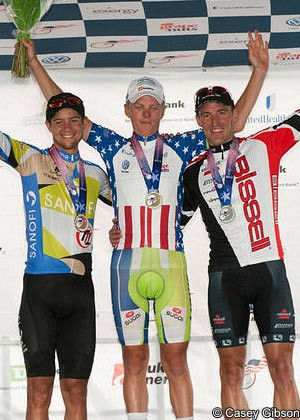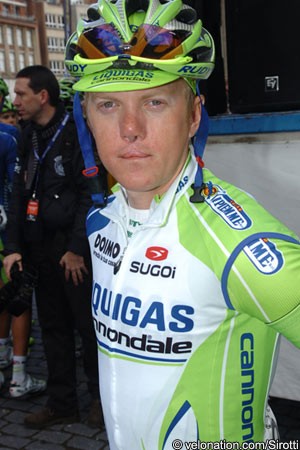American rider moves to a new level after years of knocking on the door
 Liquigas’s 29 year-old US pro Timmy Duggan has come a long way back from that day in the 2008 Tour of Georgia when he hit the tarmac at 100 km/h and was left with life-threatening injuries.
Liquigas’s 29 year-old US pro Timmy Duggan has come a long way back from that day in the 2008 Tour of Georgia when he hit the tarmac at 100 km/h and was left with life-threatening injuries.
A year later it looked as if his rehabilitation was complete with a fine second place on a Dauphiné mountain stage. However, 2010 was blighted by health and injury issues.
Season 2011 promised to be better, boosted by the news that he’d signed for Italian ‘super squadra’ Liquigas.
After six years with Jonathan Vaughters at TIAA-Cref, Slipstream and Garmin-Transitions, Duggan decided that it was time for change.
Prior to his days with JV he was a regular on the podium at the US U23 titles – second in the time trial in 2003 and 2004 and third in 2004 in the road race – but hadn’t taken a national title.
His first season with Liquigas saw him ride the Worlds in Copenhagen and take a top 10 on GC in the Tour of Utah.
This season kicked off in the Tour de San Luis in Argentina followed by a spell in Europe before playing a very impressive team role in Peter Sagan’s amazing Tour of California performance. Duggan towed the bunch along for considerable lengths of time, and it was clear that he was coming into some very good shape.
In the aftermath of that race, sixth in the US elite time trial champs behind David Zabriskie boded well for the road race.
And so it proved, as Duggan took the coveted title in Greenville, South Carolina in the face of stiff opposition from Garmin, BMC and a raft of highly motivated domestic teams.
Duggan took time to talk to VeloNation about what was a much-praised win.
VeloNation: Congratulations, Timmy – was the Nationals a big goal?
Timmy Duggan: It’s been a goal for many years. This year I trained to have my best condition for May – with the Tour of California and the Nationals.
VN: What was the pre-race plan for Liquigas?
TD: With just the two of us (Duggan and team mate Ted King) it was both a good and bad thing.
Garmin had eight and some of the teams had up to eleven; it meant we had to play our cards wisely and couldn’t make mistakes.
The plan was to have one in the break – as we did last year when Ted got bronze – and one in the bunch to cover.
When we went away, it wasn’t really a break, just a split; about thirty rolled away, with some of the favourites in there, and me.
It meant I could hide out and wait for the selection which always comes last time up Paris Mountain.
VN: Who were the danger men?
TD: There were several in the move; Tejay van Garderen, last year’s winner, Matt Busche, George Hincapie – who was highly motivated to win on his home course – and five Garmins.
VN: What’s the course like?
TD: Paris Mountain has to be climbed four times on the big circuits, then it goes to three laps of the finishing circuit, which is a pretty cool circuit, it’s pretty technical – much like a kermis circuit, actually.
But you have to keep in mind that it’s a ways to the finish from the top of Paris.
One of the factors in the race is the weather – it’s always 30 degrees and that makes it very taxing.
We didn’t have our usual Liquigas support staff with us so we enlisted friends and put together a support group.
We had a mechanic, soigneur – and folks to hand up bottles on the climb.
VN: You went solo on the finishing circuit…how did that unfold?
TD: There were only five of us left over the top of Paris for the last time – Tom Danielson (Garmin), Matthew Busche (Radio Shack), Ben-Jacques Maynes (Bissell) and me.
I went with twenty kilometres to go; I was banking on tactics behind me – the others looking at each other and not getting organised.
That always happens, guys get tired, other guys are looking back to see if they have a team mate coming up – it was my only choice, with no room for mistakes.
I held out to win by 26 seconds; but the rest got caught – it was Bissell’s Frank Pipp who took the silver and Team Type 1’s Kiel Reijnen who took bronze.
VN: Garmin seemed to get it wrong?
TD: They looked very good to start, they had five in the break and were driving; but Farrar was dropped third time up Paris – and despite having Danielson and Talansky it didn’t work out for them.
VN:  Remind us about the ‘Just Go Harder’ scholarships you organise – will your title make a difference to it?
Remind us about the ‘Just Go Harder’ scholarships you organise – will your title make a difference to it?
TD: The scholarships offset program fees for a couple of different local sports organisations.
Cycling and skiing are both expensive sports and these scholarships go to kids who couldn’t afford to have these opportunities otherwise.
My win will generate good publicity for it, yes.
VN: Cannondale ‘invented’ the colour-coded frame, with Cipo – what can we expect for you?
TD: I’ve seen drawings of possible colour schemes for my new Cannondale Evo; lots of red white and blue – they’re cool!
VN: And will there be some of that Italian design flair in the new champion’s jersey?
TD: There are two or three designs in the works – I’m looking forward to seeing how the red, white blue works with Liquigas lime green!
VN: How has your programme been with Liquigas this season?
TD: It’s been good – I rode San Luis, Catalonia and Pais Vasco before California.
I had a few allergies in Europe but came good when I got back to the US. That was a great experience; we delivered Peter Sagan for the win, five times – pretty cool!
VN: What’s the programme, now?
TD: Next up is the Tour de Suisse, than I have the Tour of Poland.
But the highlight of my season will be lining up for the Tour of Colorado in August – my home race, wearing the national champion’s jersey…